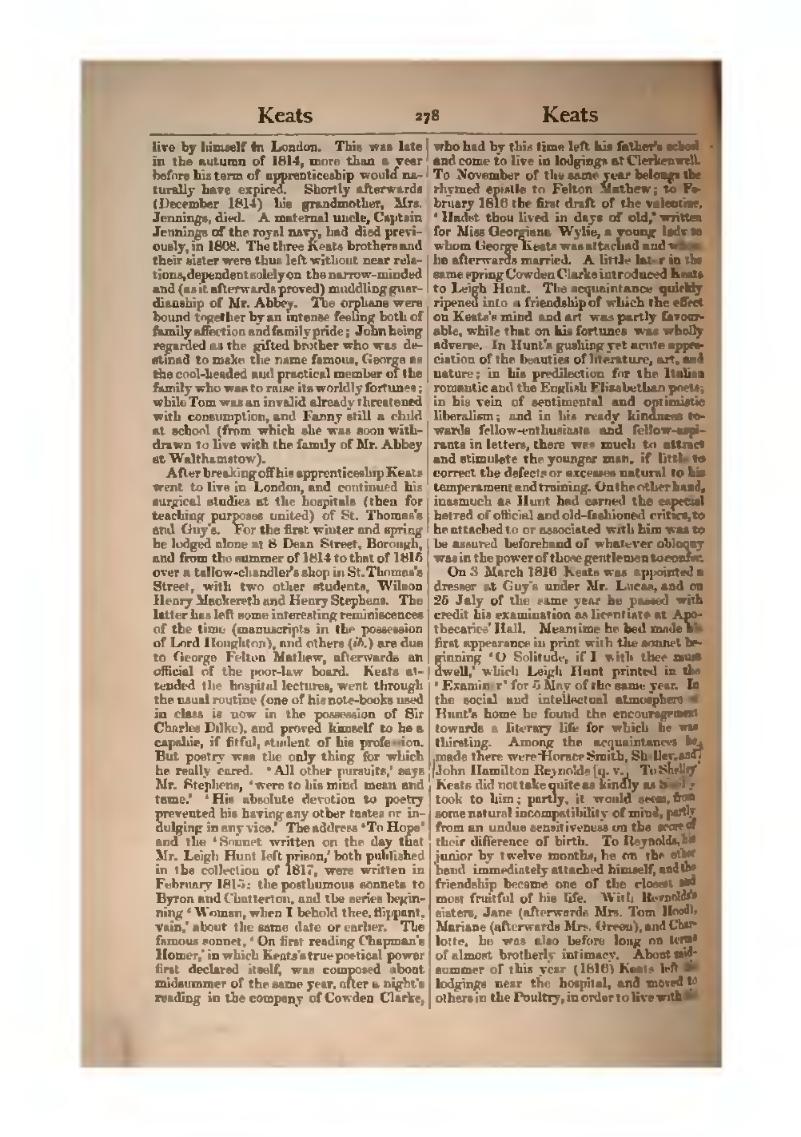live by himself in London. This was late in the autumn of 1814, more than a year before his term of apprenticeship would naturally have expired. Shortly afterwards (December 1814) his grandmother, Mrs. Jennings, died. A maternal uncle, Captain Jennings of the royal navy, had died previously, in 1808. The three Keats brothers and their sister were thus left without near relations, dependent solely on the narrow-minded and (as it afterwards proved) muddling guardianship of Mr. Abbey. The orphans were bound together by an intense feeling both of family affection and family pride; John being regarded as the gifted brother who was destined to make the name famous, George as the cool-headed and practical member of the family who was to raise its worldly fortunes; while Tom was an invalid already threatened with consumption, and Fanny still a child at school (from which she was soon withdrawn to live with the family of Mr. Abbey at Walthamstow).
After breaking off his apprenticeship Keats went to live in London, and continued his surgical studies at the hospitals (then for teaching purposes united) of St. Thomas's and Guy's. For the first winter and spring he lodged alone at 8 Dean Street, Borough, and from the summer of 1814 to that of 1815 over a tallow-chandler's shop in St. Thomas's Street, with two other students, Wilson Henry Mackereth and Henry Stephens. The latter has left some interesting reminiscences of the time (manuscripts in the possession of Lord Houghton), and others (ib.) are due to George Felton Mathew, afterwards an official of the poor-law board. Keats attended the hospital lectures, went through the usual routine (one of his note-books used in class is now in the possession of Sir Charles Dilke), and proved himself to be a capable, if fitful, student of his profession. But poetry was the only thing for which he really cared. 'All other pursuits,' says Mr. Stephens, 'were to his mind mean and tame.' 'His absolute devotion to poetry prevented his having any other tastes or indulging in any vice.' The address 'To Hope' and the 'Sonnet written on the day that Mr. Leigh Hunt left prison,' both published in the collection of 1817, were written in February 1815: the posthumous sonnets to Byron and Chatterton, and the series beginning 'Woman, when I behold thee, flippant, vain,' about the same date or earlier. The famous sonnet, 'On first reading Chapman's Homer,' in which Keats's true poetical power first declared itself, was composed about midsummer of the same year, after a night's reading in the company of Cowden Clarke, who had by this time left his father's school and come to live in lodgings at Clerkenwell. To November of the same year belongs the rhymed epistle to Felton Mathew; to February 1816 the first draft of the valentine, 'Hadst thou lived in days of old,' written for Miss Georgiana Wylie, a young lady to whom George Keats was attached and whom he afterwards married. A little later in the same spring Cowden Clarke introduced Keats to Leigh Hunt. The acquaintance quickly ripened into a friendship of which the effect on Keats's mind and art was partly favourable, while that on his fortunes was wholly adverse. In Hunt's gushing yet acute appreciation of the beauties of literature, art, and nature; in his predilection for the Italian romantic and the English Elizabethan poets; in his vein of sentimental and optimistic liberalism; and in his ready kindness towards fellow-enthusiasts and fellow-aspirants in letters, there was much to attract and stimulate the younger man, if little to correct the defects or excesses natural to his temperament and training. On the other hand, inasmuch as Hunt had earned the especial hatred of official and old-fashioned critics, to be attached to or associated with him was to be assured beforehand of whatever obloquy was in the power of those gentlemen to confer.
On 3 March 1816 Keats was appointed a dresser at Guy's under Mr. Lucas, and on 25 July of the same year he passed with credit his examination as licentiate at Apothecaries' Hall. Meantime he had made his first appearance in print with the sonnet beginning 'O Solitude, if I with thee must dwell,' which Leigh Hunt printed in the 'Examiner' for 5 May of the same year. In the social and intellectual atmosphere of Hunt's home he found the encouragement towards a literary life for which he was thirsting. Among the acquaintances he made there were Horace Smith, Shelley, and John Hamilton Reynolds [q. v.] To Shelley Keats did not take quite as kindly as Shelley took to him; partly, it would seem, from some natural incompatibility of mind, partly from an undue sensitiveness on the score of their difference of birth. To Reynolds, his junior by twelve months, he on the other hand immediately attached himself, and the friendship became one of the closest and most fruitful of his life. With Reynolds's sisters, Jane (afterwards Mrs. Tom Hood), Mariane (afterwards Mrs. Green), and Charlotte, he was also before long on terms of almost brotherly intimacy. About midsummer of this year (1816) Keats left his lodgings near the hospital, and moved to others in the Poultry, in order to live with his

